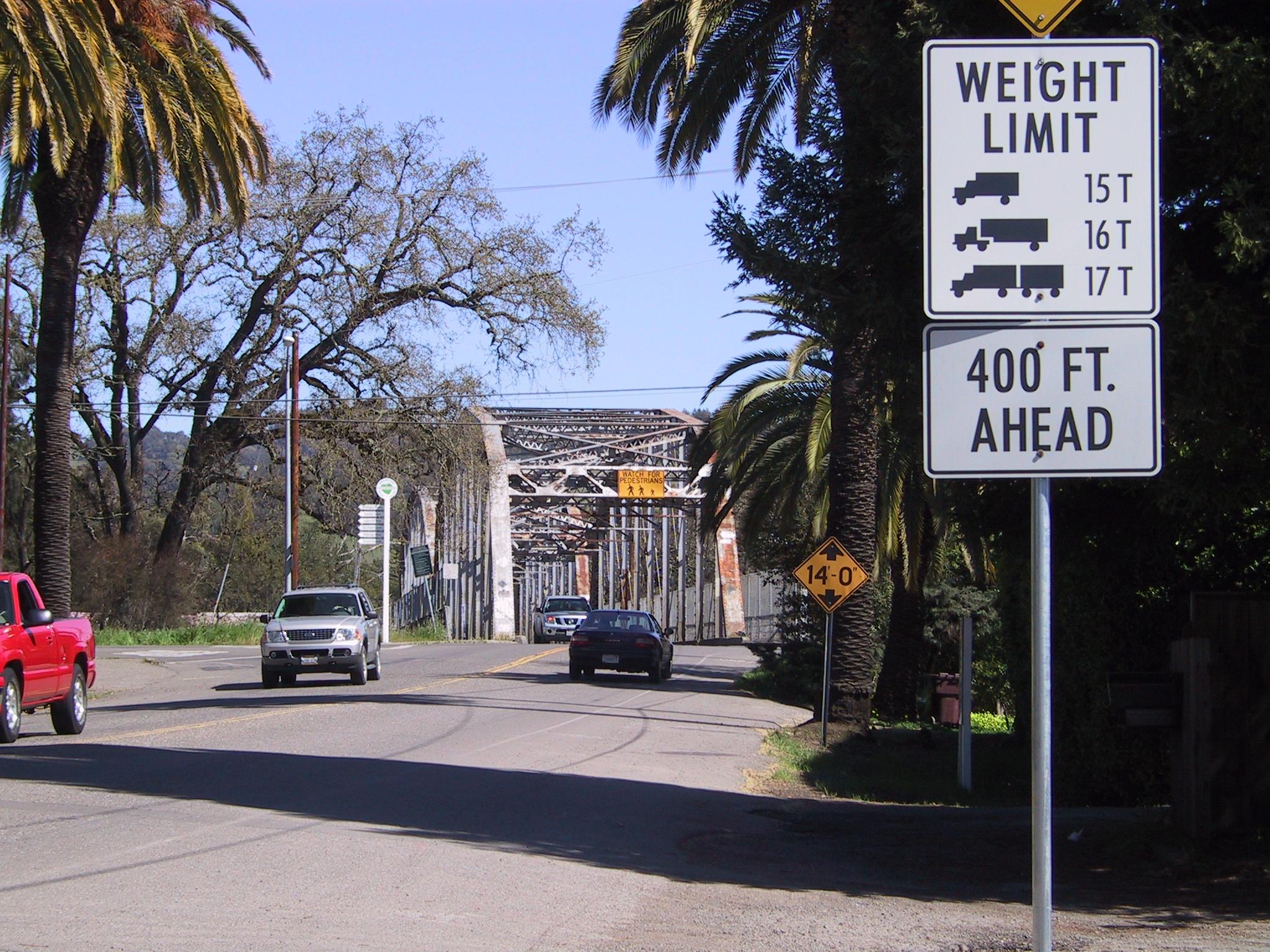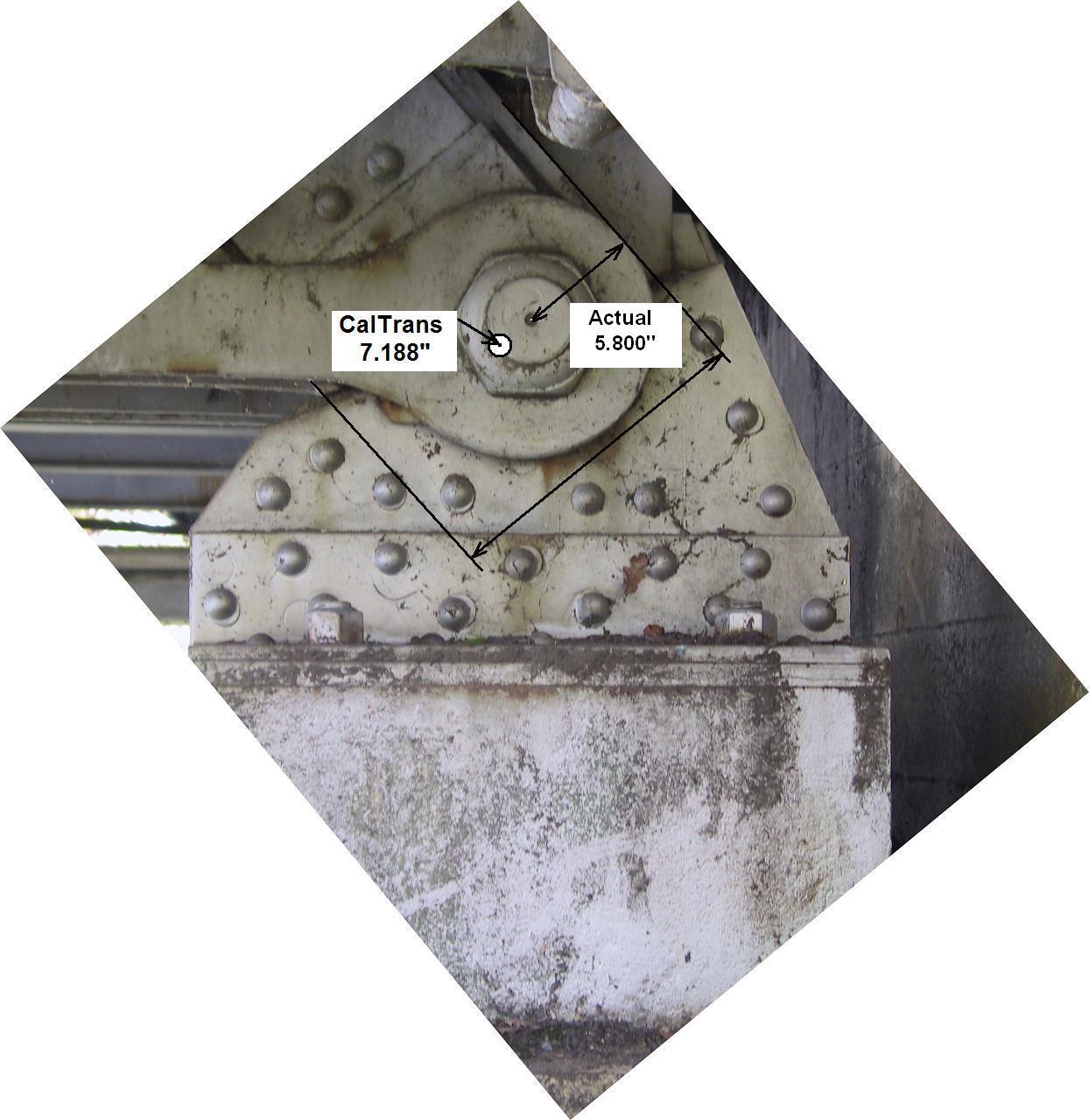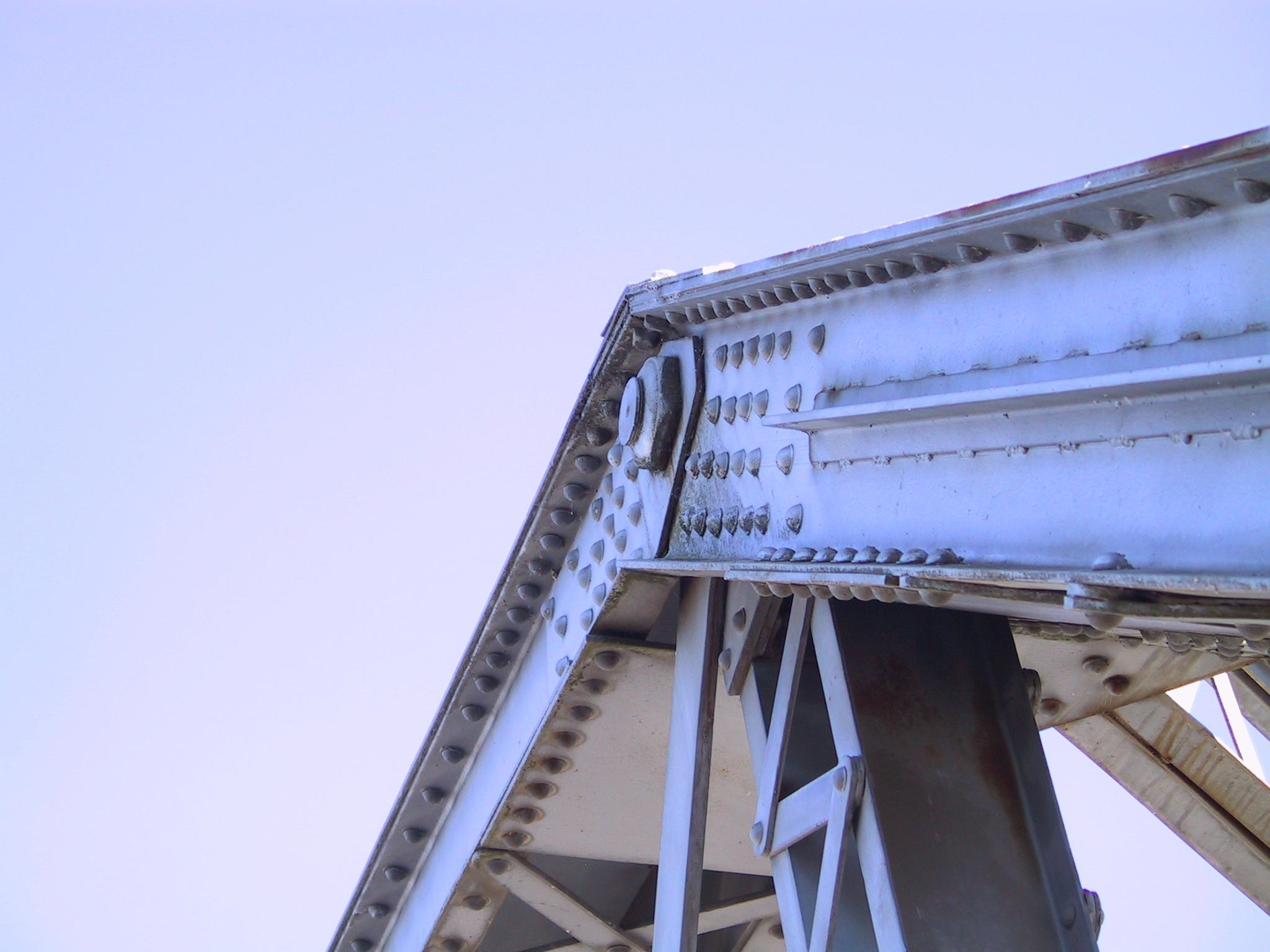How We Got Here –
1921-2007
The Healdsburg Memorial Bridge quietly passed from county to city ownership in December, 1980, when Healdsburg annexed a swath of land across the Russian River, including the gravel extraction operation then called Basalt Rock Co, now known as Syar Industries Inc.
Our city’s lack of enthusiasm for its new acquisition can be traced to the bridge’s abysmal 1979 structural rating, a reputation that encouraged Healdsburg leaders to make repeated attempts to demolish it, only to encounter fierce opposition within the community.
Caltrans had calculated the structural ratings in 1979. The Inventory
Rating – short term  truck weight capability with safety factor of 5 – (IR) was
“zero” tons. Using an IR of “zero”; the bridge could only support its own
weight and no more. Its Operating Rating – day-in and day-out truck weight
capability with safety factor of 2.5 (OR) was 15 tons. A fully legal bridge has an OR of 36
tons which means it will safely support a 36 ton truck. Our bridge’s resulting Sufficiency
Rating - a calculated composite figure of merit for bridges (SR) was determined
to be a frightening “2” on a scale of 1 to 100.
truck weight capability with safety factor of 5 – (IR) was
“zero” tons. Using an IR of “zero”; the bridge could only support its own
weight and no more. Its Operating Rating – day-in and day-out truck weight
capability with safety factor of 2.5 (OR) was 15 tons. A fully legal bridge has an OR of 36
tons which means it will safely support a 36 ton truck. Our bridge’s resulting Sufficiency
Rating - a calculated composite figure of merit for bridges (SR) was determined
to be a frightening “2” on a scale of 1 to 100.
Both the SR of 2 and the IR of “zero” used the “as built”
configuration of the bridge. Caltrans did not find it necessary to derate due
to age or rust. An IR of “zero” should have raised a rating credibility flag
but it did not. In 1983, because of this ominously low rating, our city Council
imposed and posted a truck weight restriction of 15 tons. It would be 25 years
until the validity of this weight limit would be questioned and subsequently lifted.
 In 1990, our city initiated a study and a plan to demolish
and replace the Memorial Bridge. Because our Memorial Bridge is eligible for
listing on the NRHP (National Register of Historic Places) and is listed in
California’s Historic Inventory, a full environmental study was prepared
according to the requirements of CEQA (California Environmental Quality Act),
NEPA (National Environmental Protection Act) and Section 106 and 4(f) of the
federal DOTA (Department of Transportation Act). This study resulted in a
Negative Declaration (recommendation to demolish and replace).
In 1990, our city initiated a study and a plan to demolish
and replace the Memorial Bridge. Because our Memorial Bridge is eligible for
listing on the NRHP (National Register of Historic Places) and is listed in
California’s Historic Inventory, a full environmental study was prepared
according to the requirements of CEQA (California Environmental Quality Act),
NEPA (National Environmental Protection Act) and Section 106 and 4(f) of the
federal DOTA (Department of Transportation Act). This study resulted in a
Negative Declaration (recommendation to demolish and replace).
In response to a community outcry to save the Memorial Bridge,
our City did not act on this Declaration. Unfortunately, they also did not act
to maintain or rehabilitate the bridge.
In 2000, our city contracted for an engineering design to seismically retrofit the bridge support structure for earthquake resistance. This retrofit would also replace the center support pier with a modern pier to protect that support against undermining due to raging, winter river currents. Caltrans mandated that this retrofit be implemented and has repeatedly earmarked the funds to do so. Despite multiple year funding earmarks, our city has never acted to apply for those funds.
They believed the erroneous Caltrans’ ratings to be correct and did not wish to invest in what they considered to be a structurally unsound bridge. But in 2007, this story would take a surprising and dramatic turn.
A 29-Year Calculation Error Uncovered – 2007- Present
In 2007, our city contracted with HDR, another engineering
firm, to report on the possible Memorial Bridge options including
rehabilitation and demolition/replacement. Councilman  Gary Plass requested that
Mel Amato, a Healdsburg resident, review the HDR report and provide feedback. Mr.
Amato requested and received the 1979 Caltrans structural calculations from the
City and the bridge construction drawings from the County. The 1979,
handwritten Caltrans spreadsheet confirmed the abysmal, as-built ratings of OR=15
tons, IR=”zero” tons and SR=2. (See
documentation HERE)
Gary Plass requested that
Mel Amato, a Healdsburg resident, review the HDR report and provide feedback. Mr.
Amato requested and received the 1979 Caltrans structural calculations from the
City and the bridge construction drawings from the County. The 1979,
handwritten Caltrans spreadsheet confirmed the abysmal, as-built ratings of OR=15
tons, IR=”zero” tons and SR=2. (See
documentation HERE)
He hypothesized that the calculations must be flawed since it would have been senseless and not credible that a bridge would be constructed with an “about to fall into the river” rating. Using professional structural software and the bridge drawings, Mr. Amato confirmed that most of the Caltrans’ supporting data was correct. Undaunted, he dug deeper into the Caltrans’ calculations.
After detailed scrutiny of the Caltrans’ 1979 calculations for over 1 month, Mr. Amato uncovered a fundamental error. Caltrans had erroneously assumed the pins supporting the upper individual truss members were located on the geometric centerline of the upper trusses. Because the truss member cross section is not rectangular but has an inverted “U” shape; a centrally located pin substantially reduces the calculated structural load capacity of each truss member, and hence, the entire bridge. However, visual examination of the bridge clearly shows the pins to be off-center (vertically higher) – just where they should be for an inverted “U” shape.
Mr. Amato crawled under the bridge to measure the only
easily accessible pin to determine a typical pin location. Using that data and
estimates from photos of other pins taken by him and his son Tony Amato, he
revised and corrected the Caltrans’ calculations. The ratings  were dramatically
improved with the OR becoming fully legal (above 36 tons), the IR at 24 tons
(not “zero”) and the SR at 54 (not 2).
were dramatically
improved with the OR becoming fully legal (above 36 tons), the IR at 24 tons
(not “zero”) and the SR at 54 (not 2).
In December of 2007, Mr. Amato reported these findings at a meeting with the then City Manager, the Directory of Public Works, two City Councilmen and the Chair of the Planning Commission. These new results triggered a Caltrans’ bridge re-inspection in August of 2008.
In their follow-up November 2008 inspection report, Caltrans confirmed and corrected most (but not all) of the pin location errors. As a result, Mr. Amato’s findings of a fully legal OR (above 36 tons) was confirmed. Caltrans rescinded (lifted) the city’s long standing (25 years) posted weight limit. According to Caltrans, the IR was 16 tons and the SR 44. Detailed hands-on and ultrasonic inspection of the critical truss members and truss pins uncovered no cracks or flaws. Underwater inspection by Caltrans divers found no problems with pier undermining.
The noted Caltrans’ report supporting the safety of Memorial Bridge is found on our city’s website. Click on the link and then on "Request for Proposals". Check pages 81, 82, 86 & 87. Click HERE to see the documents.
Rehabilitation now became a technically feasible, financially superior (replacement is double to triple the cost) and historically preferable option. After receiving partial federal bridge funding through Caltrans, in March of 2010 the city advertised for bids to complete a 3 phase engineering project to evaluate, provide option decision information and ultimately to generate designs for either the rehabilitation or demolition/replacement options. Omni-Means was hired as the successful bidder.
On March 18, 2010, the bridge was again reinspected, this time by the Omni-Means’ project team member and subcontractor, Cornerstone Structural Engineering Group. The results of those measurements are reported on the 5/6/2010 Final Sufficiency Rating Evaluation Summary Report posted on our city’s project website, http://healdsburgbridge.com/. As summarized in the document presented by Mel Amato at the city's May 11 public meeting "Get the Facts", their Sufficiency Rating is in error and our bridge project is not eligible for Federal Funds for a replacement bridge. It is only eligible for rehabilitation funding.